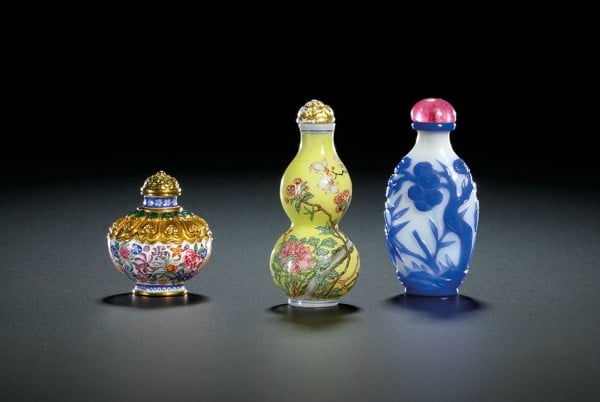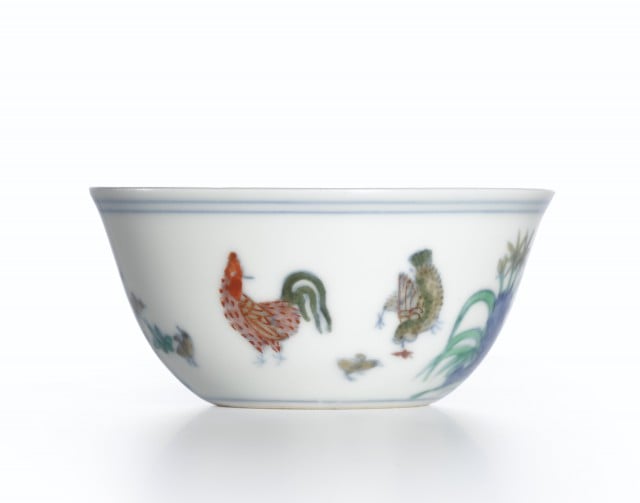Analysis
Sotheby’s Sales Jump 24 Percent in First Half of 2014


Rozalia Jovanovic


The Meiyintang Chicken Cup. Courtesy Sotheby’s.
Sotheby’s released its report of financial results for the first half of 2014 this morning announcing a healthy 24 percent increase in net auction sales to $2.7 billion—led by Hong Kong and London—a 42 percent increase in adjusted operating income, and a 20 percent increase in operating income.
The increase in net auction sales led to an 18 percent increase in auction commission revenues to $403 million compared to the year before. In the public auction market place, the auction house sold 487 lots for more than $1 million. In addition, 26 percent of its buyers were first-time clients.
On the Chicken Cup and Other Top Lots
Taking the top lot on Sotheby’s list of its top 20 works sold at auction globally was Claude Monet’s Nympheas (1906). The work sold in London at the Impressionist and Modern sale in June for £31.7 million (or $54 million). Francis Bacon’s Three Studies for Portrait of George Dyer (1964), which sold for £26.7 million (or $45.4 million) taking the second spot, also sold at the London auction in June. And the Meiyintang collection “Chicken Cup,” which made headlines when a Chinese collector charged the $36.3 million item to his Am Ex at Sotheby’s Hong Kong.
On Expenses Connected to Daniel Loeb and Triple Point LLC
As per “special charges,” according to executive vice president and chief financial officer Patrick McClymont, who along with president and CEO Bill Ruprecht, spoke on a conference call this morning, Sotheby’s incurred $18.6 million in the quarter and 24.3 million in the half to legal and other professional service fees directly linked to issues related to the shareholder activism and resulting proxy contest with Third Point LLC (Daniel Loeb’s investment advisory firm) and the associated litigation. McClymont said the auction house expects to recover part of the professional service fees related to the litigation but couldn’t say how much that would be.
On the Asian Collector
Sotheby’s reported a 35 percent increase in the number of buyers from Mainland China in its auctions globally.
With regard to the health of the Asian buyer for the first half of the year, Ruprecht said, “In our New York sales series, Asian consumers were very vigorous. In hong kong in early april we had a very very strong series of sales in comparison to the prior period. Up something on the order of 40-50 percent on prior periods.”
While Ruprecht acknowledged there’s been “a lot written about Chinese bullishness or Chinese bearishness and some indication suggestions there’s a new stimulation round going on in China that could potentially freshen demand for great works of art,” he said the auction house’s experience through the sales have been “rewarding and reassuring” with regard to the continued appetite for great works of art from the collector base in broader China.
On Private Sales, Numbers Up from Last Year but Dollar Figure Down
The number of transactions and the relevance of the private channel to Sotheby’s audience and the company’s ability to “penetrate and engage” with customers has gone up dramatically, according to Ruprecht, who stated there were 40 percent more transactional events in private sales. Planned for the fall are more than a dozen selling exhibitions. While the number of private sale transactions in this period was up over last year, the dollar figure is down because last year the auction house had some very large figure sales. While he said the news was “positive,” Ruprecht said he didn’t see any huge fundamental shift in the demand for high value works in the private marketplace. “I don’t see any particular thunderclouds there.”
On eBay
On the eBay and Sotheby’s partnership, Ruprecht noted that the auction house was amping up to reach a much broader audience by distributing its events through the popular online auction site.
“When you have, at our most expansive sales, 12-1500 people in a room, and a couple of hundred people on the phone, you have through the distribution of these events, and the ability to participate in these events, for 100 plus million people, you completely change the inclusiveness and the opportunity to participate in what we’re currently doing.”
Ruprecht said that having the “the eBay customer coming into our traditional live business as a corollary audience” is going to teach the auction house “quite a lot about what some of the steps and the other kinds of sales that we offer to that community.”
As a “barometer of who eBay is,” Ruprecth noted that the online auction company sells over 3,500 objects a day for more than $5,000 rendering a strong overlap with the kinds of sales Sotheby’s marshals in the $5,000 to $100,000 space.
“I think it’s important to understand that we view the art collecting community holistically,” said Ruprecht. “This is not an online versus offline community. Most people use both channels. And our job is to be inclusive and to get the very best most exciting offering on both platforms that are reinforcing to one another.”